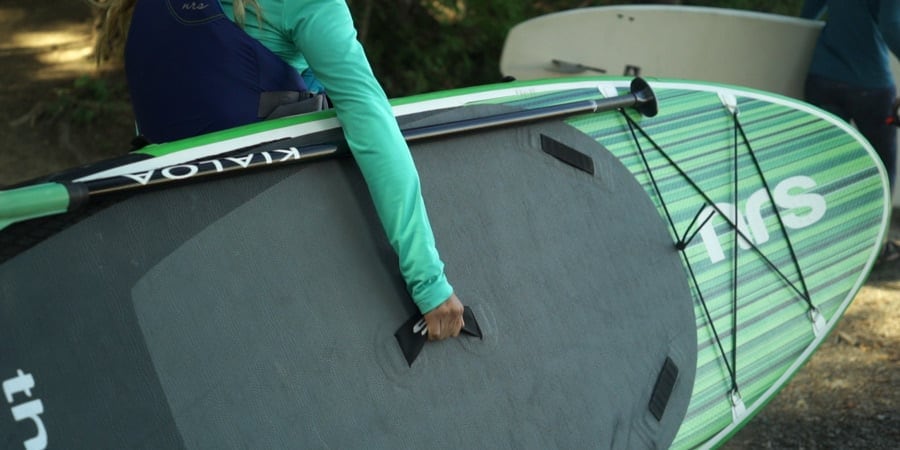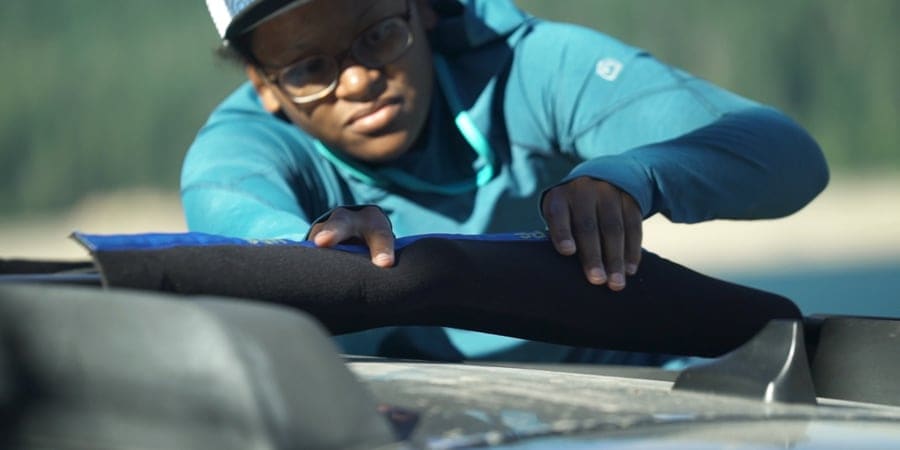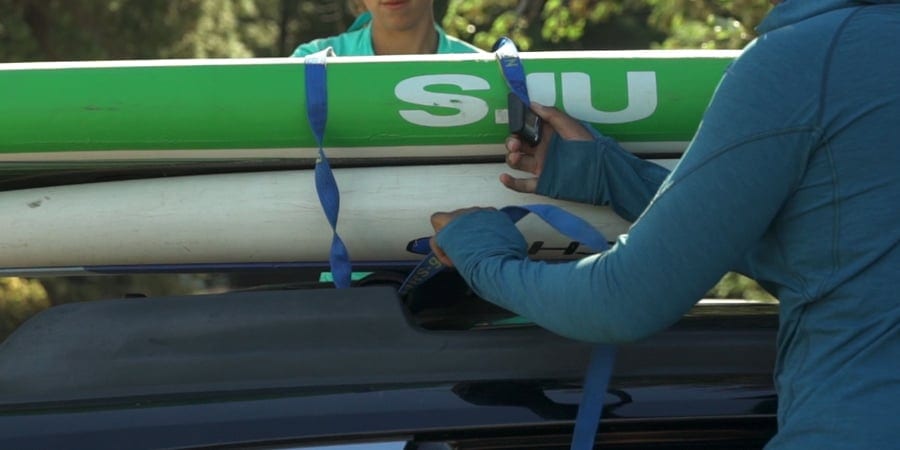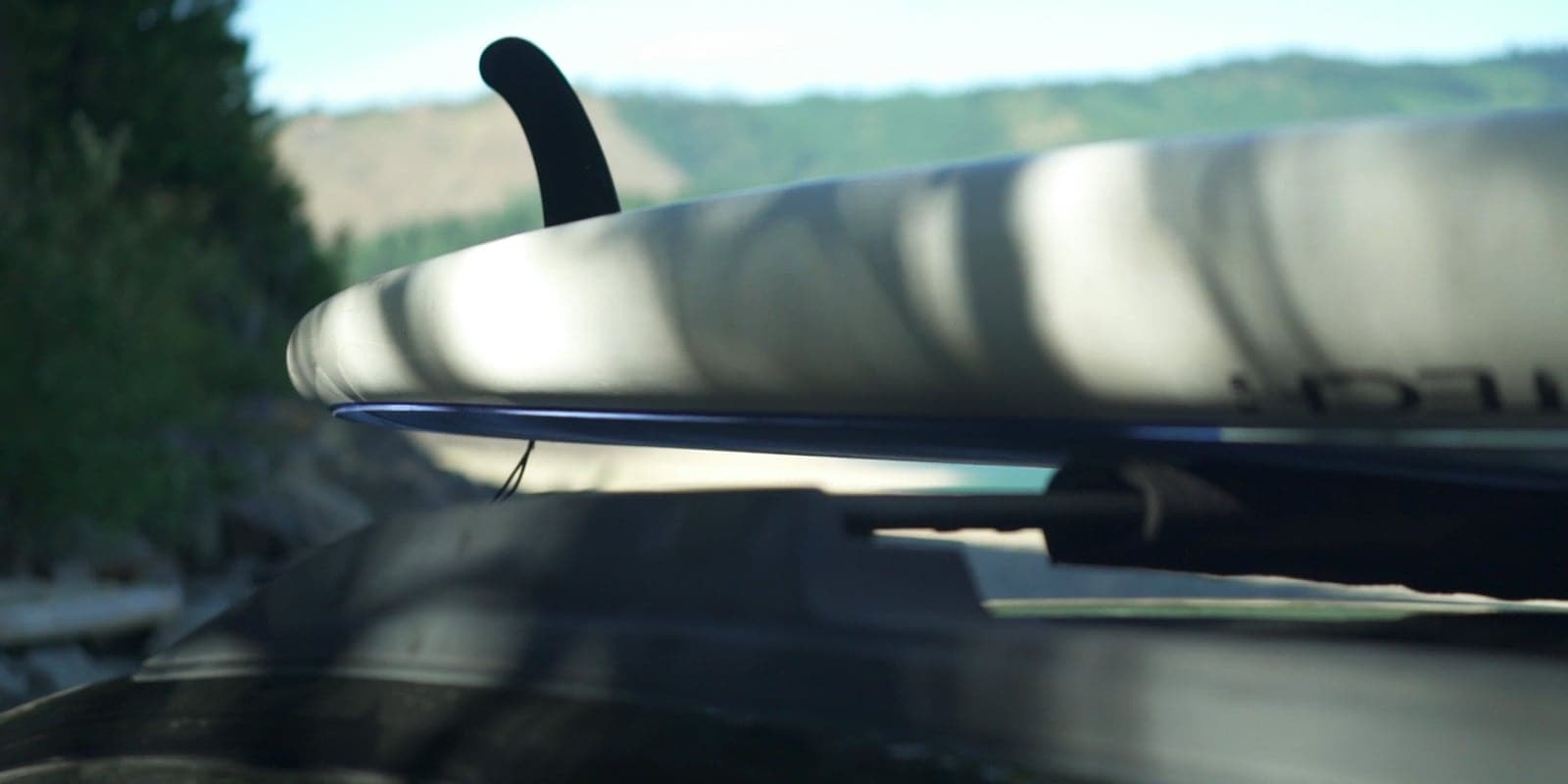Unless you live walking distance from a body of water, you're going to need to put your stand up paddle board on your vehicle in order to go paddling. Transporting a SUP is not all that difficult, but it's important to do it right to make sure your board stays secure.
In this video, we show you:
- How to carry a SUP: There's a carry handle at the center of the board that makes this easier to do.
- How to put a SUP on a vehicle: You can lift the board overhead and place it on top, or lean it against the rear of your vehicle and slide the board into place.
- How to strap the board down: Cam straps are the simplest and fastest way to secure the boat.
Video: Transporting Your SUP
How to Carry a SUP

Nearly all SUPs have a carry handle located at the center of the board. This makes carrying the board straightforward. Here's how to carry a paddle board:
- Stand the board up on its side so the base of the board is next to you and the nose is facing forward.
- Reach over the top edge of the board to grab the carry handle and lift.
Tips for Carrying a SUP
- Protect your back: Bend with your knees and keep your back straight when reaching down to pick up your SUP.
- Be ready for wind: A strong crosswind can toss your board around when you pick it up, so be ready. It's best to hold your board on the downwind side of your body, and, if at all possible, point your board into the wind while carrying it.
- Use a cart: If you find carrying a SUP by hand to be too difficult, look into a cart with wheels.
- Stow your paddle: To keep one hand free, you can tuck your paddle between the board and the arm that is carrying the board.
Putting a SUP on Your Vehicle
The type of vehicle you have determines exactly how you'll transport a SUP. If you have a truck, it's possible to simply put the board deck-side down in the bed with the nose supported by the tailgate. However, for many people with sedans, station wagons and vans, the only option is to put the board on the roof.

To securely stow a SUP on the roof of a vehicle, you need a handful of essentials:
- Crossbars: Crossbars run across the roof of your vehicle. Most crossbars attach to factory-installed bars that run front to back on your car, but this depends on your vehicle type. There are even crossbar systems that go in the bed of a truck.
- Rack/padding: There are specific SUP rack systems that attach to the crossbars and make transporting a board very simple and secure. Or you can use basic foam blocks or padding.
- Cam straps: Cam straps quickly and securely hold your SUP down. You'll need two straps that are about 12 feet long or longer.
- Bow and stern lines: You can use a nonstretch, water-resistant rope, but special ratcheting lines make the job quick and easy. You need one line for the bow and one for the stern.
With the crossbars and rack/padding installed and the straps/lines nearby, you can place your SUP on top of your vehicle.
With two people, lifting a SUP is simple. You each grab an end, lift the board overhead and place it deck-down on the rack with the fins toward the front of the car. But, if you're by yourself, it can be a bit trickier. Here's how to load a SUP onto your vehicle by yourself:

For shorter vehicles (sedans, wagons, etc.):
- Lean the board against the side of the car with the deck facing you and the fin at the front of the car.
- Grab the handle with one hand and the upper edge of the SUP in the other.
- Lift the board onto your knee and grab the other edge with the hand that was on the handle.
- Lift the board over your head.
- Place the board deck-down on the rack or padding.

For taller vehicles (SUVs, minivans, trucks, etc.):
- Place your board deck down and fin forward near the back of your vehicle.
- Lift the tail of the board onto the back of your car.
- Slide the board up and forward until it's in place.
Tips for Transporting SUPs:
- Don't forget your paddle: If it fits, your paddle can go right inside your vehicle. If it doesn't, look into a paddle holder that attaches to your roof rack.
- Put the longest SUP on first: If you're going to put more than one SUP on your roof, you'll orient them the same way and stack them on top of each other. Start with the longest SUP, then stack the shorter one on top of it. Put padding between the SUPs to prevent damage.
- Pad your truck's tailgate: If you decide to stow your board in the bed of your truck, put some padding down on top of the tailgate to protect the board. Also, make sure to secure your board in the bed so it doesn't jostle around too much. For longer boards, it's a good idea to put red flagging on the nose to warn other drivers.
How to Tie Down a SUP

If you're using a rack designed specifically for carrying a SUP, you may only need to cinch down a couple built-in straps and you'll be on your way. If you're using foam blocks or padding, the easiest way to tie down your SUP is with two cam straps.
Here's how to tie down a SUP with cam straps:
- Position your SUP so it is running parallel with the car and with the widest point of the board between the crossbars of your rack.
- Take a cam strap and position the buckle so it is resting on top of the board but near the edge. It should be close to one of the crossbars. Toss the other end of the strap over your SUP.
- Walk around to the other side of your vehicle and grab the strap and loop it underneath the crossbar then toss it back over your board. Make sure the strap is to the inside of where the crossbar attaches to the vehicle. This will prevent the strap from slipping off the end of the crossbar.
- Walk back around your vehicle and loop the strap underneath the crossbar then up into the cam buckle and cinch it down. Again, make sure the strap is to the inside of where the crossbar attaches to the vehicle.
- Repeat with the other strap on the other crossbar.
- Tighten both straps until snug, but not overtight. Too much tension can deform a SUP.
- Tie off the loose ends of the straps just below the cam buckles, then tie any remaining slack to the crossbars. This backs up the cam buckles and prevents the slack from flapping around while you're driving.
- Grab hold of either end of the SUP and shake it from side to side to make sure it is secure.
Bow and stern straps: If you have a really long SUP or will be driving in high winds, it's recommended to use bow and stern lines in addition to the cam straps. Using ratcheting lines makes it simple. Here's how to install ratcheting bow and stern lines:
- Hook the end of the line with the ratchet to a secure point on the tail of the SUP, such as the leash loop.
- Attach the other end of the line to a secure point on your vehicle, such as a tow hook. If you don't have a secure point, you can install a hood loop strap to create one. Never attach the tie-down straps to plastic parts on your car.
- Pull the free end of the line down to tighten the line until snug. Be careful not to overtighten.
- Tie off the loose end of the line just below the ratchet.
- Repeat with the bowline. (Note: not all SUPs have a secure attachment point on the bow. If your board does not, you'll need to add one. Options include suction cup anchors.)
Tips for Tying Down a SUP:
- Keep it simple: Using fancy knots and wrapping straps every which way to secure a SUP may look cool, but keeping things simple is often the fastest and most-secure way to go.
- Use a ladder: If you're shorter and/or have a tall vehicle, keep a small stepladder in the back of your car that you can use to make reaching the straps a whole lot easier.
- Find the widest point: Position the widest point of your board between the two cam straps. This will help prevent the board from sliding forward or backward.
- Add a twist: Putting a simple twist in the cam straps can help prevent annoying strap vibration from developing while you're driving.
- Lock the straps: You can buy locking cam straps that can only be unfastened with a key. These can give you peace of mind when leaving your board on your car for a quick run into a store or restaurant. If you're leaving your SUP for an extended time, you'll need a more secure solution, such as a locking cable.
- Know the trucker's hitch: If you don't have cam straps or ratcheting bow and stern lines, you can use rope instead. Make sure it is nonstretch and water-resistant. And know how to tie a trucker's hitch so you can get the lines nice and tight.
- Stop and check: After about 15 minutes of driving, pull over and give the SUP at tug to make sure it is still secure. Sometimes the straps can loosen up a while driving.

